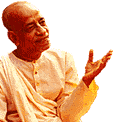Chapter 11: The Universal Form
Bg 11.48
TEXT 48
na veda-yajnadhyayanair na danair
na ca kriyabhir na tapobhir ugraih
evam-rupah sakya aham nr-loke
drastum tvad anyena kuru-pravira
na ca kriyabhir na tapobhir ugraih
evam-rupah sakya aham nr-loke
drastum tvad anyena kuru-pravira
SYNONYMS
na—never; veda—Vedic study; yajna—sacrifice; adhyayanaih—studying; na danaih—by charity; na—never; ca—also; kriyabhih—by pious activities; na tapobhih—by serious penances; ugraih—severe; evam—thus; rupah—form; sakyah—can be seen; aham—I; nrloke—in this material world; drastum—to see; tvat—you; anyena—by another; kuru-pravira—O best among the Kuru warriors.
TRANSLATION
O best of the Kuru warriors, no one before you has ever seen this universal form of Mine, for neither by studying the Vedas, nor by performing sacrifices, nor by charities or similar activities can this form be seen. Only you have seen this.
PURPORT
The divine vision in this connection should be clearly understood. Who can have divine vision? Divine means godly. Unless one attains the status of divinity as a demigod, he cannot have divine vision. And what is a demigod? It is stated in the Vedic scriptures that those who are devotees of Lord Visnu are demigods. Those who are atheistic, i.e., who do not believe in Visnu, or who only recognize the impersonal part of Krsna as the Supreme, cannot have the divine vision. It is not possible to decry Krsna and at the same time have the divine vision. One cannot have the divine vision without becoming divine. In other words, those who have divine vision can also see like Arjuna.
The Bhagavad-gita gives the description of the universal form, and this description was unknown to everyone before Arjuna. Now one can have some idea of the visva-rupa after this incidence; those who are actually divine can see the universal form of the Lord. But one cannot be divine without being a pure devotee of Krsna. The devotees, however, who are actually in the divine nature and who have divine vision, are not very much interested to see the universal form of the Lord. As described in the previous verse, Arjuna desired to see the four-handed form of Lord Krsna as Visnu, and he was actually afraid of the universal form.
In this verse there are some significant words, just like veda-yajnadhya-yanaih, which refers to studying Vedic literature and the subject matter of sacrificial regulations. Veda refers to all kinds of Vedic literature, namely the four Vedas (Rk, Yajus, Sama and Atharva) and the eighteen Puranas and Upanisads, and Vedanta-sutra. One can study these at home or anywhere else. Similarly, there are sutras, Kalpa-sutras and Mimamsa-sutras, for studying the method of sacrifice. Danaih refers to charity which is offered to a suitable party. such as those who are engaged in the transcendental loving service of the Lord, the brahmanas and the Vaisnavas. Similarly, pious activities refer to the agni-hotra, etc., the prescribed duties of the different castes. Pious activities and the voluntary acceptance of some bodily pains are called tapasya. So one can perform all these, can accept bodily penances, give charity, study the Vedas, etc., but unless he is a devotee like Arjuna, it is not possible to see that universal form. Those who are impersonalists are also imagining that they are seeing the universal form of the Lord, but from Bhagavad-gita we understand that the impersonalists are not devotees. Therefore they are unable to see the universal form of the Lord.
There are many persons who create incarnations. They falsely claim an ordinary human to be an incarnation, but this is all foolishness. We should follow the principles of Bhagavad-gita, otherwise there is no possibility of attaining perfect spiritual knowledge. Although Bhagavad-gita is considered the preliminary study of the science of God, still it is so perfect that one can distinguish what is what. The followers of a pseudo incarnation may say that they have also seen the transcendental incarnation of God, the universal form, but that is not acceptable because it is clearly stated here that unless one becomes a devotee of Krsna, one cannot see the universal form of God. So one first of all has to become a pure devotee of Krsna; then he can claim that he can show the universal form of what he has seen. A devotee of Krsna cannot accept false incarnations or followers of false incarnations.
Copyright (c) 1972 by His Divine Grace A.C. Bhaktivedanta Swami Prabhupada










